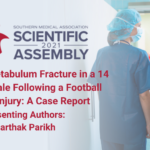Abstract | November 8, 2021
Pediatric Acetabulum Fracture in a 14 Year Old Male Following a Football Related Injury: A Case Report
Learning Objectives
- Discuss the benefits of operative vs non-operative management of pediatric acetabular fractures.
- Demonstrate a surgical approach to treating pediatric acetabular fractures.
Introduction: Pediatric acetabular fractures constitute only about 1%-15% of pelvic fractures in children. The mechanism of these fractures is usually derived from a force transmitted through the femoral head with a specific leg and pelvis position; acetabular fractures are a result of high energy trauma whereas triradiate cartilage trauma is due to direct injury. They are often associated with hip dislocations and are more often transverse than longitudinal involving both columns. Historically these fractures have been treated non-operatively however, many think the role of surgical treatment is expanding. The main goal in treatment is to achieve absolute anatomical reduction with a congruent joint.
Case Presentation: A 14 year old male with no past medical history presented as a transfer from another medical facility after being diagnosed with left acetabular fracture. Patient describes the pain as a 10/10 and was unable to walk or stand. A pelvic X-ray and CT scan showed a left acetabular fracture that involved the anterior and posterior column with mild to moderate displacement and nondisplaced fracture of the left inferior pubic ramus.
Final Diagnosis: Pediatric Acetabular Fracture
Management/Outcome: During surgery a Kocher-Langenbech approach was used. The posterior column was exposed in a subperiosteal plane and a transphyseal fracture was identified. Reduction of the fracture site was achieved and definitive fixation was achieved with the use of a contoured Stryker 6 hole 3.5mm Stryker acetabular plate placed on the posterior column with 5 associated 3.5mm cortical screws. Post operative xrays showed anatomic alignment with inner fragmentary compression.

